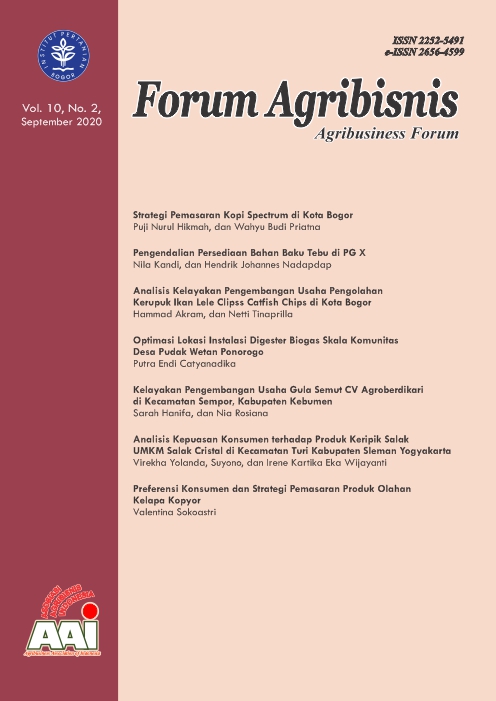Pengendalian Persediaan Bahan Baku Tebu Di PG X
Main Article Content
Abstract
Sugarcane is one of the plantation crops which is used as raw material for making sugar. The efficiency of inventory is very important for a sugar factory. The purpose of this study is to determine the order level, order frequency, the amount of safety stock (Safety Stock), re-order points (sugarcane raw material) which is economical and to know the total inventory cost (Total Inventory Cost) of sugarcane raw material economical in PG X. The method of determining the area of this research was carried out intentionally (purposive). The research method uses the descriptive-analytic method. The analytical tool used is Economic Order Quantity (EOQ), Re-Order Points (ROP), Safety Stock (SS), and Total Inventory Cost (TIC). The results of the 2018 and 2019 EOQ calculations show it is not yet economical. The 2018 EOQ calculation was 1.688,79 tons greater than the number of orders made by PG X by 1.483,9 tons and the 2019 EOQ calculation was 3.074 tons greater than the number of bookings made by PG X by 976,6 tons. The value of the safety stock in 2018 amounted to 1.483,9 tons and in 2019 it was 976,6 tons. The value of ROP in the supply of raw sugar cane in 2018 was 2.967,8 tons and in 2019 it was 1.953,2 tons. The 2018 TIC value is Rp. 139.031.870 smaller than the cost of inventory incurred by the company of Rp. 158.302.102 and the 2019 TIC value of Rp. 208.014.632 less than the cost of inventory incurred by the company of Rp. 654.250.185. The results of the last two years calculations indicate the inefficiency of orders made because it causes the frequency of orders is greater and the inventory costs incurred by PG X are higher., so with economic calculations, the order frequency will be less and the total cost of inventory will be lower.
Downloads
Article Details

This work is licensed under a Creative Commons Attribution-ShareAlike 4.0 International License.
The author submitting the manuscript must understand and agree that the copyright of the article manuscript must be submitted/transferred to the Journal Forum Agribisnis. This work is licensed under the Creative Commons Attribution-ShareAlike 4.0 (CC BY-SA) International License in which the Author and Reader can copy and redistribute the material in any media or format, and remix, modify and build material for any purpose, but they must provide appropriate credit (citing articles or content), provide a link to the license, and indicate whether there is a change. If you mix, change, or create material, you must distribute your contribution under the same license as the original.
References
Haming, M., & Numajamuddin, M. (2014). Manajemen Produksi Modern Operasi Manufaktur dan Jasa Buku 2 (2nd ed.; A. Novianty, ed.). Jakarta: PT Bumi Aksara.
Heizer, J., & Barry, R. (2016). Manajemen Operasi : Manajemen Keberlangsungan dan rantai pasokan. Jakarta: Salemba Empat.
Hermawan, I. (2012). Analisis penggunaan luas lahan tebu dan padi terkait dengan pencapaian swasembada gula di indonesia. Jurnal Ekonomi Dan Kebijakan Publik, 3(1), 47–63.
Iqbal, T., Aprizal, D., & Wali, M. (2017). Aplikasi Manajemen Persediaan Barang Berbasis Economic Order Quantity (EOQ). Jurnal JTIK (Jurnal Teknologi Informasi Dan Komunikasi), 1(1), 48. https://doi.org/10.35870/jtik.v1i1.33
Jan, A. H., & Tumewu, F. (2019). Analisis economic order quantity (eoq) pengendalian persediaan bahan baku kopi pada pt . fortuna inti alam. Jurnal EMBA, 7(1).
Prasetyo, B. D. (2017). Menuju Industri Gula Yang Berdaya Saing. Seminar Nasional Agribisnis, 6. Indonesia: Universitas Galuh Ciamis.
Rahmawati, R., Rahayu, E. S., & Ani, S. W. (2018). Analisis Penerapan Economic Order Quantity (Eoq) Di Pabrik Gula Madukismo Bantul. Caraka Tani: Journal of Sustainable Agriculture, 32(2), 126. https://doi.org/10.20961/carakatani.v32i2.15120
Sulastri, L. (2012). Manajemen. Bandung: La Good’s.
Yuliana, C., & Sudjana, N. (2016). Penerapan model eoq (economic order quantity) dalam rangka meminimumkan biaya persediaan bahan baku (studi pada UD. Sumber Rejo Kandangan-Kediri). Jurnal Administrasi Bisnis S1 Universitas Brawijaya, 36(1), 1–9.

